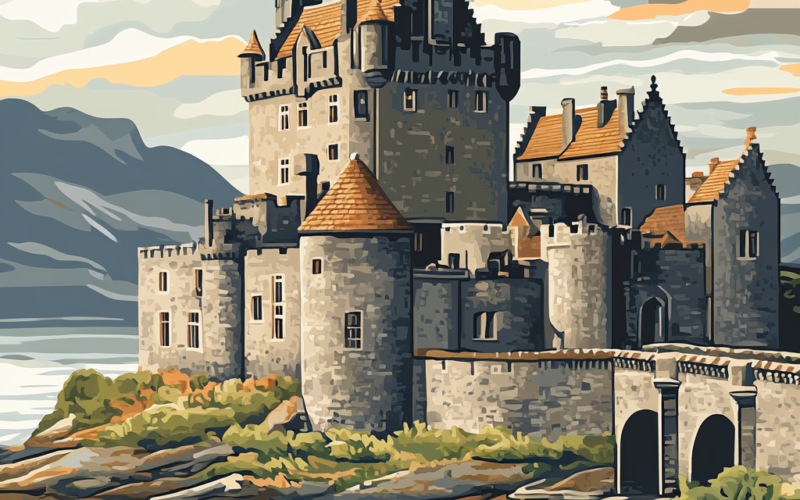Historical significance of Scottish castles
Scottish castles they represent not only important architectural monuments, but also key elements of the country’s cultural and historical heritage. Castles began to be built in the 12th century as strategic fortifications to protect territories from attacks by hostile neighbors. In those days, castles served not only as defensive structures, but also as political centers where important decisions were made. Many of them were the residences of Scottish monarchs, including such iconic figures as Robert the Bruce and Mary Stuart, whose fate was closely linked with these magnificent buildings.
Scotland’s castles have survived many historical events, including battles of independence, civil wars, conquests and sieges. Some castles were destroyed, while others have survived to this day, becoming symbols of perseverance and greatness. Nowadays, castles attract not only historians, but also tourists who want to touch the rich history of the country, see the places of coronations, diplomatic meetings and royal celebrations that preserve the imprints of past eras.
Architectural features of Scottish castles
The architecture of Scottish castles is unique and varied, reflecting changes in building traditions over several centuries. Early castles were built with an emphasis on military defense: massive walls, high towers, narrow windows and loopholes made it possible to effectively withstand sieges. The walls of the castles were built from stone, which not only provided strength, but also merged with the surrounding landscape, making the castle a part of nature.
Later, during the Renaissance, many castles were rebuilt, acquiring elements of luxury. Decorative elements, arched windows, carved fireplaces, and courtyard gardens were added to the architecture. These changes reflected not only technological progress, but also the desire of castle owners for comfort and aesthetics. Today’s tourists can see both strict, ascetic castles and luxurious palace complexes where monarchs and noble families once lived.
Famous castles of Scotland
Edinburgh Castle is one of Scotland’s most famous and emblematic castles, perched on a cliff in the center of the capital. It served as the residence of Scottish kings and was home to ancient artifacts such as the Crown of Scotland and the Stone of Destiny, on which monarchs were crowned. Today, Edinburgh Castle is not only a tourist attraction, but also a venue for state events and ceremonies, while maintaining its historical significance.
Another famous castle is Stirling, located on a hill and surrounded by thick walls. The castle played a key role in the fight for Scottish independence, being the site of many important battles, including the famous Battle of Stirling. The castle is also famous for its ornate royal apartments and breathtaking views of the surrounding area. Both castles attract thousands of tourists who want to plunge into the past and see the grandeur of medieval Scotland.
Tourist routes to the castles of Scotland
Tourist routes to Scottish castles offer unique opportunities to get acquainted with the history and culture of the country. One popular route runs along the west coast of Scotland, starting at Inverness Castle and continuing through Urquhart and Eilean Donan Castles. These castles are surrounded by picturesque landscapes of mountains and lakes, and each of them is associated with interesting historical events and legends that enliven the tours.
Another popular route passes through central Scotland and includes visits to Stirling, Blackness and Linlithgow castles. These castles immerse tourists in the atmosphere of medieval Scotland, revealing to them the secrets of royal dynasties and famous battles. These routes provide an opportunity to see different styles of castle architecture, enjoy natural beauty and get a sense of Scottish history.
Legends and myths associated with Scottish castles
Scottish castles are surrounded by many legends and myths passed down from generation to generation. One of the most famous stories is the legend of Lady Gray, a ghost who is said to haunt Glamis Castle. They say that she appears in the castle hall, and her appearance is always accompanied by strange sounds and foreshadows tragic events. This legend continues to attract the attention of tourists and paranormal investigators.
Eilean Donan Castle is also surrounded by mystical stories. According to legends, the castle was built on the site of an ancient Celtic sanctuary, making it a place of unusual occurrences. Tourists often talk about strange light phenomena, sounds and the appearance of mysterious figures on the castle grounds. These legends make visiting castles not only historically interesting, but also a mystically exciting experience for all visitors.
Modern use of locks for events and recreation
Many Scottish castles are now used as popular venues for celebrations and events. They have become sought-after venues for weddings, business conferences and cultural events, offering guests a unique atmosphere and luxurious interiors that combine ancient architecture with modern amenities. Organizing weddings in castles such as Edinburgh or Stirling has become particularly popular among those seeking exclusive and formal ceremonies in a historical setting.
In addition, some castles offer their guests the opportunity to stay overnight. For tourists, this is a chance not only to immerse themselves in the atmosphere of the past, but also to feel like a part of history, living in ancient apartments. Castles often offer rooms with unique interiors, where every element of the design is reminiscent of bygone centuries.
- Edinburgh and Stirling Castles offer venues for weddings and corporate events.
- Some castles provide overnight accommodation, offering exclusive rooms and unique conditions for guests.
- Many castles in Scotland have become venues for cultural events, festivals and concerts.
- Modern castles are often used as film sets for films and TV series, which adds to their popularity.
- Some castles offer themed parties and historical re-enactments, attracting history buffs and unusual entertainment.
Scottish castles do not lose their significance in our time. They continue to be a symbol of luxury, history and cultural heritage, attracting tourists and offering unique event opportunities.
Questions and answers
Answer 1: Castles served as strategic fortifications and residences of rulers, playing a key role in the history of the country.
Answer 2: Massive stone walls, towers and loopholes, as well as decorative elements from the Renaissance.
Answer 3: Edinburgh Castle and Stirling Castle are both symbols of Scottish history.
Answer 4: Popular routes are along the west coast and through central Scotland.
Answer 5: Legends about the ghost of Lady Gray in Glamis Castle and mystical phenomena in Eilean Donan Castle.

